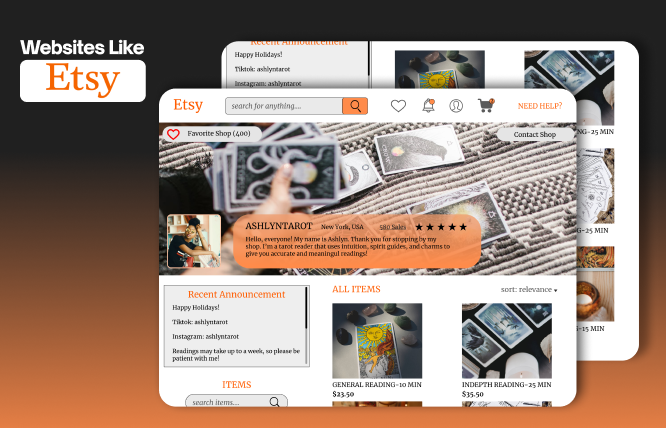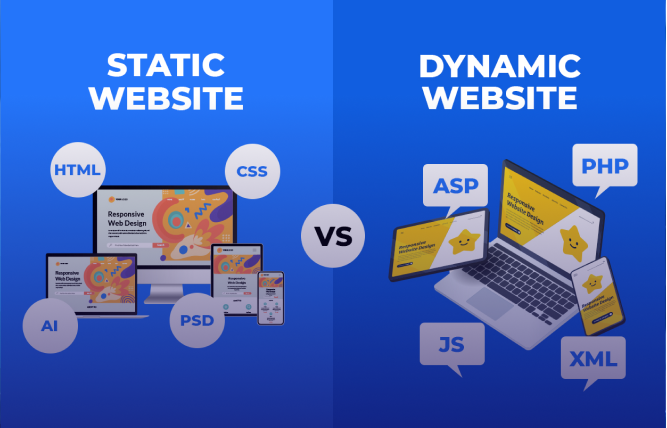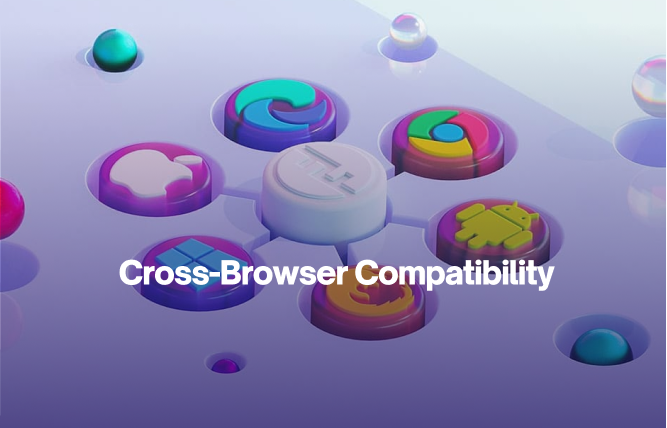Introduction
Creating websites like Etsy demands thoughtful planning and investment. Important components include implementing key features, designing a user-friendly interface, selecting the right platform, and properly understanding the Etsy model before development. Costs encompass possible revenue streams, ongoing operations, and development. If you can balance effectively implement these factors, you can establish a prosperous online marketplace.
We are living in some interesting times, especially for online shoppers. This is because websites like Etsy, online marketplaces for vintage, handmade, and craft items have gained popularity. It is their success that has inspired a several entrepreneurs to make likewise platforms. However, an important question arises here: How do you build websites like Etsy? Or What are the costs of creating suc websites?
this blog is here to answer these questions for you.
Getting to Know the Etsy Model
Let’s understand how Etsy operates. At its core, Etsy is a reliable platform that connects sellers with buyers for handcrafted and unique products. Important features of the platform include:
Seller Tools: Sellers have access to order fulfilment features, inventory management, and analytics.
Payment and Shipping: Etsy integrates various payment gateways, offering important payment and shipping tools.
Shopping Cart and Checkout: It has an easy-going and user-friendly checkout process that is vital for conversions.
Search and Discovery: Etsy’s search assists buyers in quickly and easily finding desired products, while the recommendation algorithms suggest products based on browsing history and interests.
User Profiles: Sellers and buyers can create profiles. Sellers can manage reputation and build trust to encourage conversions.
Product Listings: Sellers can create detailed listings with descriptions, images, and variations.
Etsy is known for generating revenue via advertising, transaction fees, and listing fees.
Creating Websites Like Etsy
Let’s start with selecting a platform.
Selecting the Right Platform
The first step is to determine how to create a websites like Etsy. You have three key options to choose from.
Marketplace-as-a-Service (MaaS): This is a well-regarded emerging model. It is a pre-built marketplace platform that you can alter to some degree. Experts call it a reasonable option between custom development and DIY.
Custom Development: If you want unique features and full control, go with custom development. However, it is the most time-consuming and expensive of the options available.
DIY Platforms: These platforms offer pre-built tools and templates to make online stores. Some popular options include Magento, WooCommerce, and Shopify. However, with convenience come limited customisations.
Let’s do a quick comparison of these platforms:
| Feature | Marketplace-as-a-Service | Custom Development | DIY Platforms |
Cost | Medium to High | High | Low to Medium |
Time | Medium | Long | Quick |
Flexibility | Medium | High | Limited |
Features | Extensive | Extensive | Basic |
Important Features & Functionality
To build successful websites such as Etsy, you need reliable features that serve both sellers and buyers. Let’s do a breakdown of the most critical ones:
For Buyers
Intuitive Product Discovery
Advanced Search: Allows buyers to search using filters for occasion, material, vintage, and so on.
Browse: Curated product recommendations, collections, and categories based on purchase behaviour and browsing history to inspire buyers and introduce them to new items.
Search: A reliable and intelligent search engine with sorting and filtering options (by size, colour, category, price, and so on) to assist buyers in getting what they are looking for. Leverage search and autocomplete suggestions for a refined browsing experience.
Detailed Product Listings
Variations: Lets sellers offer product variations (such as colour and size) with corresponding images and clear descriptions.
Reviews and Ratings: Allow buyers to give ratings and reviews to create trust and social proof. Additionally, let sellers respond to reviews and keep up open communication.
Detailed Descriptions: Offer detailed descriptions that include care instructions, materials, product dimensions, and the seller’s story (if applicable).
High-Quality Images: Display products clearly and with a couple of images from different angles. Think about having zoom functionality and 360-degree views for intricate items.
Seamless Checkout and Shopping Cart
Clear Order Confirmation: Offer a clear order confirmation page that includes an estimated delivery time, a summary of purchased items, and order tracking details.
Safe and Secure Checkout: Include a safe and secure payment gateway with differentpayment options, such as PayPal, debit cards, and credit cards so people can pay through their preferred payment method.
Guest Checkout: Give the option of guest checkout for a quicker purchasing experience, while incentivising account creation, such as loyalty programs.
Shopping Cart: An easy-going and customer-friendly shopping cart that lets buyers include, remove, and update item quantities. Offer an option to save carts for a later checkout.
Customer Support & Communication
Customer Support: Present responsive customer support via phone, live chat or email for effectively sorting customer issues or personalised assistance.
Help Center: Establish a detailed help centre with guides, tutorials, and FAQs to address some of the most common questions and offer self-service support.
Direct Messaging: Support direct communication between buyers and sellers via a messaging system for customisation requests, order details, and inquiries.
For Sellers
Creation & Management of Shop
Digital Assets Management: Allow sellers to store, upload and manage high-resolution product videos and images.
Inventory Management: Include inventory management tools to manage variations, track stock levels, and set reorder points to avoid stockouts.
Product Listing Tools: A user-friendly interface for sellers to efficiently edit, include, and manage product listings.
Shop Storefront: Offer sellers appropriate tools to create informative and visually appealing shop storefront that reflects their brand identity.
Order Fulfilment & Shipping
Integration with Shipping Carriers: Integrate with today’s most renowned shipping carriers to streamline shipment tracking, label generation, and possibly discounted shipping rates for sellers.
Shipping Profiles: Allow sellers to create configurable shipping profiles with different shopping options (carriers, delivery times, costs) based on dimensions, weight, and location.
Order Management: A central dashboard for sellers to manage, process, and view orders. This should have the capability to track shipments, print shipping labels, and mark orders as shipped.
Shop Reporting & Analytics
Shop Reviews and Feedback: Allow sellers to both view and respond to shop reviews and feedback to build trust and improve customer satisfaction.
Marketing Tools: Allow sellers to use various marketing tools to promote their offerings in the marketplace (e.g., product recommendations and sponsored listings).
Sales Performance Insights: Offer sellers insightful reports and data on customer demographics, conversion rates, traffic sources, and sales performance.
Additional Features to Consider
Seller Subscriptions: Consider a tiered subscription model for sellers, offering additional benefits or features.
Personalised Recommendations: Apply a recommendation engine to suggest products to buyers based on their purchase behaviour, browsing history, and similar customer purchases.
Wishlist Functionality: Let buyers make wish lists to save products for buying later or share with gift-givers.
Social Proof: Include social sharing buttons to let buyers share their purchases on social media, driving brand awareness and driving traffic.
Design & User Experience
Website developers understand that a great user experience is vital for the success of websites like Etsy. And here is what to focus on for a good user experience:
SEO and Marketing: Try your best to optimise your site for search engines and apply appropriate marketing strategies.
Mobile Optimisation: Make sure that your website functions and appears well on all mobile screens.
Visual Appeal: Utilise high-quality images and attractive design elements.
Intuitive Interface: You should try to make it as easy as possible for users to navigate your website.
Cost Breakdown
Creating websites like Etsy comes at a cost. Let’s look at them in some detail:
Possible Revenue: Transaction fees, listing fees, and advertising can generate revenue.
Ongoing Costs: Marketing expenses, payment processing fees, security, domain, and hosting are among the ongoing costs you will incur.
Development Costs: This cost includes custom development, platform fees, and design.
The overall cost is directly related to your marketing efforts, the number of features, and the platform you select. Before starting your marketing, it is best to consult with marketing professionals in your network or hire a development agency that also offers marketing services.Monetisation Strategies
You can monetise websites like Etsy in different ways, such as:
Subscription Fees: Offer additional services or features for subscription fees.
Advertising: Present advertising spaces for third-party advertisers or sellers.
Transaction Fees: Charge a percentage for each sale.
Listing Fees: Charge sellers an amount of fees for product listing.
Legal &Regulatory Considerations
It is critical that prior to releasing websites like Etsy, make sure that you comply with relevant laws and regulations, some of which may include:
Tax Implications: Get to properly know your tax obligations as a marketplace operator.
Consumer Protection Laws: Safeguard buyer rights and ensure fair practices.
Payment Processing Regulations: Adhere to security standards and payment processing laws.
Intellectual Property Rights: Safeguard your platform alongside user-generated content.
Concluding Remarks
Creating websites like Etsy demands thoughtful and well-crafted marketing, planning, and development. If you can properly understand the Etsy model and take account of the factors mentioned in this blog, you can build a reliable online marketplace.
Remember that there is fierce competition so make sure your platform offers value to both sellers and buyers.
Finally, if you require consultation with a website development company in Dubai, contact FuturByte. We are a renowned software and website development company that enjoys a globally situated client base, and we would love to help you in creating sites like Etsy.
Frequently Asked Questions
Essential elements include getting to properly know the Etsy model, designing a user-friendly interface, selecting a platform, and applying key features such as checkout, search, and product listings.
The costs can vary, and this will depend on the choice of features, design complexity, and platform. Costs will also depend on your marketing strategy and your investment in ongoing maintenance. Possible revenue streams such as transaction fees and listing fees can offset expenses.
Etsy’s biggest competitor is Amazon Handmade.
Have questions or feedback?
Get in touch with us and we‘l get back to you and help as soon as we can!




